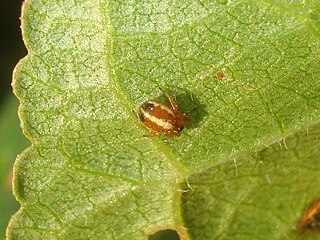
The genus Argiope includes rather large spiders that often have a strikingly coloured abdomen. These spiders are distributed throughout the world. Most countries in tropical or temperate climates host one or more species that are similar in appearance. The etymology of Argiope is from a Latin word argentum meaning silver. The carapace of Argiope species is typically covered in silvery hairs, and when crawling in the sun, they reflect it in a way that gives them a metallic, white appearance.
Ipa is a genus of dwarf spiders that was first described by Michael I. Saaristo in 2007.

Argiope keyserlingi is a species of orb-web spider found on the east coast of Australia, from central New South Wales to northern Queensland. It is very similar in appearance to a closely related North-Queensland species, Argiope aetherea. A. keyserlingi is commonly found in large populations in suburban parks and gardens, particularly among the leaves of the Lomandra longifolia. Like many species of orb-web spider, A. keyserlingi shows considerable sexual size dimorphism, as the females are many times larger than the males. Mature females can be seen during the summer months and it is not uncommon to see multiple males on the web of one female.

Argiope aetherea is a common, large orb-web spider. Like other species of Argiope, it is commonly known as the St Andrew's Cross spider, due to the characteristic cross-shaped web decorations female spiders often include in their webs. A. aetherea is similar in appearance to A. keyserlingi, however female A. aetherea are generally larger than A. keyserlingi. Like most orb-web spiders, A. aetherea shows considerable sexual size dimorphism, with females being many times larger than males.
Antillattus is a genus of Caribbean jumping spiders that was first described by E. B. Bryant in 1943. The name is a combination of "Antilles" and the common ending for salticid genera -attus.
Eustiromastix is a genus of jumping spiders that was first described by Eugène Louis Simon in 1902.

Opisthoncus is a genus of South Pacific jumping spiders that was first described by Ludwig Carl Christian Koch in 1880. There are still many Australian species that have not yet been described.
Zebraplatys is a genus of jumping spiders that was first described by Marek Michał Żabka in 1992.

Zygiella is a genus of orb-weaver spiders first described by F. O. Pickard-Cambridge in 1902. In 2015, Parazygiella was determined to be a taxonomic synonym of Zygiella, and its species were moved to Zygiella.
Phoneutria keyserlingi is a species of spiders in the family Ctenidae, found in Brazil.

Argiope pulchella is a species of the orb-weaver spider family, Araneidae. It ranges from India to China and can be found on Java. It is a synanthropic species, often living in habitats associated with humans.
Orcevia is a genus of Asian jumping spiders that was first described by Tamerlan Thorell in 1890. It was once considered a synonym of Laufeia, but it was revalidated in 2019.

Argiope magnifica is a species of orb web spider found in tropical areas of north-east Queensland, Australia, eastern Papua New Guinea and the Solomon Islands. It is commonly known as the magnificent St Andrew's cross spider. This species is similar in size to the sympatric Argiope keyserlingi; females can be distinguished from those of A. keyserlingi via extensive differences in abdominal colouration and patterns. The males of these two species are almost indistinguishable.
Singa eugeni is a species of orb weaver in the family of spiders known as Araneidae. It is found in the United States.

Singa, also called striped orb-weavers, is a genus of orb-weaver spiders first described by C. L. Koch in 1836. They are small for orb-weavers, reaching 6 millimetres (0.24 in) or less in body length, excluding the legs.
Philodromus keyserlingi is a species of running crab spider in the family Philodromidae. It is found in the United States and Canada.
Xenoctenidae is a family of araneomorph spiders separated from Miturgidae in 2017.

Trachelopachys is a genus of South American araneomorph spiders first described by Eugène Simon in 1897. Originally placed with the Corinnidae, it was moved to the Trachelidae in 2014.
Josa is a genus of South American anyphaenid sac spiders first described by Eugen von Keyserling in 1891. It is a senior synonym of "Gayenella", "Haptisus", "Olbophthalmus", and "Pelayo".

Trichonephila is a genus of orb-weaver spiders that was first described by Friedrich Dahl in 1911, as a subgenus of Nephila. Trichonephila was elevated to the level of genus by Kuntner et al in 2019.









